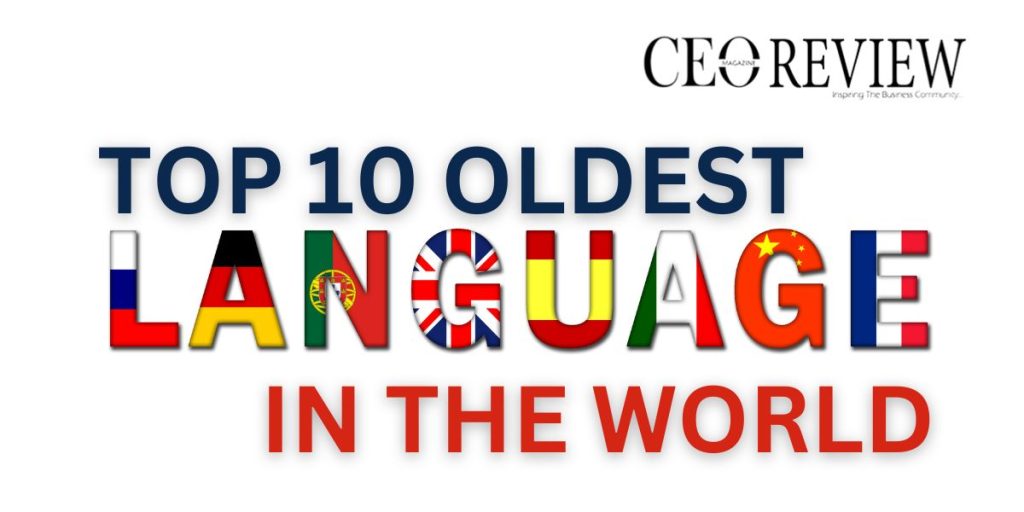Top 10 Oldest Languages in the World
The study of the world’s oldest languages offers a captivating look into the history of human communication. These ancient languages provide not only the basis for how we communicate in this day and age but also bear cultural and historical significance. In this journey, we explore the top ten oldest languages that are spoken today and trace their origins, importance, and lasting influence.
Here is the list of the top 10 oldest languages in the world:
-
Sanskrit (Over 3,500 years old)
Origin and Significance
Origins: Sanskrit’s beginnings go back to at least 2000 BCE with its earliest form found in Rigveda, a Hindu sacred text composed around that time. It is an Indo-European language specifically belonging to Indo-Iranian branch which evolved over centuries with classical Sanskrit emerging around 500 BCE mostly standardized by an ancient grammarian Panini.
Significance: Known as ‘language of the gods’ in Hinduism, understanding ancient Indian scriptures, philosophy or history would be incomplete without it. It is a liturgical language for Hindu rituals and serves as a base for Buddhism and Jainism. Some of them are Mahabharata and Ramayana (epics), numerous philosophical texts alongside extensive scientific and medical treatises were written in Sanskrit structure/grammar has deeply influenced many modern Indian languages such as Hindi, Bengali or Marathi.
Current Status
Although no longer commonly used as spoken language; prestigious ceremonies among Hindus still use it while learning Sanskrit continues to be offered at different levels of education including higher education institutions. There are communities and schools both within India and outside that aim at resuscitating everyday use of spoken Sanskrit. In Uttarakhand state of India it is one among official languages.
2. Egyptian (Over 5,000 years old)
Origin and Significance
Origins: Egyptian hieroglyphs emerged about 3400 BCE making them one of the earliest forms of writing systems ever existed on earth. The language went through several stages – Old Egyptian, Middle Egyptian, Late Egyptian, Demotic and finally Coptic which came up around the 2nd century CE.
Significance: The language and writing of Egypt were essential for recording its history as well as religious texts and administrative documents. The Rosetta Stone whose text was in Greek, Demotic and hieroglyphic Egyptian facilitated the deciphering of Egyptian hieroglyphs. Ancient Egyptian beliefs and culture are better understood through their literature like ‘Pyramid Texts’ or ‘Coffin Texts.’ Modernly, a form of ancient Egyptian referred to as Coptic is still used during liturgy by the Coptic orthodox Church with teachings carried out within these faith-based institutions.
Current Status
Today no one speaks this language on regular basis but it is studied among scholars in fields including archeology and linguistics. Within religious education system in most parts of Africa, Coptic forms part of the curriculum besides being used liturgical language within the Orthodox Church.
3. Greek (Over 2,800 years old)
Origin and Significance
Origins: The Greek language has been used for the last three millenniums, with the earliest record of its written form dating back to around 1450 BC in the form of Linear B script. Greek also evolved through significant stages such as Ancient Greek, Koine Greek, and Modern Greek.
Significance: Further, ancient Greek philosophy laid the root for western thought with the likes of Socrates, Plato and Aristotle who is among others being remembered for their contributions. For example Christian New Testament is in Greek while it was once an official language of Byzantine Empire.
Current Status
As at present there are currently about 15 million people speaking this dialect worldwide; most reside within Greece and Cyprus where it is an official language. Modern Greeks is still evolving and remains a critical cultural and literary language in Europe. In universities all over the world this language is studied for its historical significance as well as philosophical importance.
Chinese (Over 3,200 years old)
Origin and Significance
Origins: It has been a long time since people started using Chinese which has written records from Shang dynasty(around 1250BC). Some of the earliest written forms of Chinese are found on oracle bone inscriptions which were used in divination.
Significance: Furthermore, Mandarin Chinese which originated from these ancient characters is spoken by more than anyone else does throughout earth today. The evolution of Chinese writing systems from logographs to modern simplified characters shows great continuity and adaptation over ages. East Asian cultures are very much influenced by Chinese literature, philosophy including science. Also Confucianism Taoism Buddhism classical literature as book song Tao Te Ching are some cornerstones that shape China’s culture.
Current Status
There are over one billion speakers worldwide making it one of the six official languages recognized by United Nations besides Mandarin been widely spoken globally especially among Chinese communities. It is employed in diverse dialects and forms across China and its diaspora populations worldwide. Mandarin has been promoted as a national language by the Chinese government while at the same time other regional languages and dialects have been preserved.
About Tamil (Over 2,000 years old)
Origin and Significance
The Origin: Tamil is recognized as one of the oldest classical languages in the world with a continuous literary tradition dating back to at least 300 BCE. Tamil belongs to the Dravidian family of languages and has gone through different stages from ancient, medieval, to modern.
Significance: From ancient Sangam literature (c. 300 BCE-300 CE) to current-day forms, Tamil Literature offers valuable insights into ancient Tamil culture, politics, and social practices. It has been interwoven into the cultural identity of Tamils and has resulted in a vast corpus of poetry, religious texts and scholarly works written in it. Thirukkural is considered one of the best books on morality on earth.
Current Status
Millions speak Tamil in India, Sri Lanka and Singapore while these places have made it an official language for their citizens. It is actively employed in everyday communication including education, media outlets and government offices. Besides that,Tamil is also learnt or taught in academic institutions all over the globe.
Korean (Over 1,300 years old)
Origin and Significance
Origins: The origins of Korean can be traced back to Three Kingdoms period with earliest inscriptions dating back to fourth century AD. The development of Hangul which is the Korean alphabet was made by King Sejong himself during fifteenth century.
Significance: Hangul’s scientificity makes it easy for people especially ordinary people to learn how to read and write since it represents each sound uniformly across words. Korean literature as well as historical records give us remarkable accounts about Korea’s cultural background political history. Additionally, this language speaks out for Korea’s philosophical background which was influenced by Confucianism as well as Buddhism.
Current Status
In South Korea , and North Korea , there are over seventy five million Koreans worldwide who speak this language . Both South and North Korea have adopted it as their official language and this has even been reflected in their current culture, media or technology . Furthermore , Korean has become a second language to many countries mainly due to its broad acceptance in the world of Korean culture.
Aramaic (Over 3,000 years old)
Origin and Significance
Aramaic- “Origin and Significance” is a language originated in the Levant around tenth century BCE. It was used as a lingua franca by several ancient empires including Neo-Assyrian, Neo-Babylonian and Achaemenid.
Significance: Aramaic has religious significance in certain sections of the Hebrew Bible and other religious writings. It was spoken by Jesus Christ and is still used in some Christian liturgies. The Talmud, a central text of Rabbinic Judaism, was written in a combination of Hebrew and Aramaic.
Current Status
Even today there are small communities of Neo-Aramaic languages spoken in the Middle East such as among Assyrian, Chaldean, and Syriac Christians. These languages are being worked on to see they are preserved despite challenges facing these groups.
Hebrew (Over 3,000 years old)
Origin and Significance
Hebrew, “Origin and significance” is believed to have been developed around the 10th century BCE making it one of the oldest languages ever recorded on earth. It is one of the Semitic languages evolved from Proto-Canaanite language.
Significance: Hebrew has a unique history of becoming revived as an everyday spoke language after being primarily liturgical for centuries upon centuries. It belonged to Ancient Israel and Judah with key texts inclusive of Torah among other biblical writings. Hebrew’s revival during the 19th -20th century remains one of the most powerful examples for linguistic revitalization.
Current Status
Modern Hebrew today is spoken by millions people in Israel as well as Jewish communities across the globe. Its official language status in Israel encompasses education, government functions among others. Furthermore, this language serves as liturgical for Jewish religious practices up to date.
Farsi/Persian (Over 2,500 years old)
Origin and Significance
Origins: Farsi, which is part of Indo-Iranian family, dates back to about 600 BCE. Ancient Persian or Old Persian was known through cuneiform inscriptions in the Achaemenid Empire.
Significance: Persian literature has been appreciated for its poetry and intellectual contribution by scholars such as Rumi and Hafez. Throughout empires like Sassanian, Safavid, and Mughal Empires Persian was spoken as a major cultural and administrative language. It has had a wide influence on neighboring languages and cultures.
Current Status
In addition to the above mentioned countries where Farsi is spoken, there are also significant populations of speakers in many other countries. This makes it an important language of culture with rich literary heritage. In contemporary era education is conducted using modern Persian.
Latin (Over 2,600 years old)
Origin and Significance
Origins: Starting from Latium region near Rome around 7th century BC Latin developed from earlier Indo-European languages spoken in Italy during ancient times.
Significance: As well as being the language of the Roman Empire, Latin is considered as a parent to Romance languages—Italian, French Spanish Portuguese Romanian among others. It was extensively used in literature, philosophy law science administration throughout Roman Republic Empire until its fall together with its second foundation.” The most famous works of classic European literature including “Aeneid” by Virgil philosophical discourses made by Cicero were written in Latin.
Current Status
Although no longer used as a speaking language it still has great influence towards scientific field medicine law Roman Catholics church. Its study remains popular all over the world among researchers interested in medieval history as well as for those who seek to understand development of Romance languages. Legal medical scientific jargon often contains expressions from this dead language.
Conclusion
The study of these ancient languages is not only a discovery of their linguistic diversity but also a realization of the huge cultural and historical impact they have had. Languages such as Sanskrit, Egyptian, Greek and Chinese, have molded civilizations and continue to shape modern societies. An understanding of these languages provides an enhanced perspective on shared human history and the development of communication.
The past can be reached by studying these languages which offer us insight into their survival for thousands of years with modifications when necessary. These are rich historical languages that help us understand how the human race progressed from one civilization stage to another in different parts of the world. Today they are still essential within cultural traditions experienced through generations as well as academic investigations.







